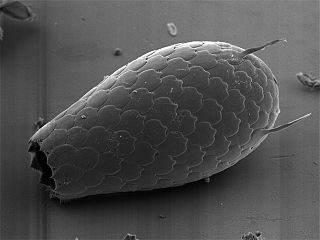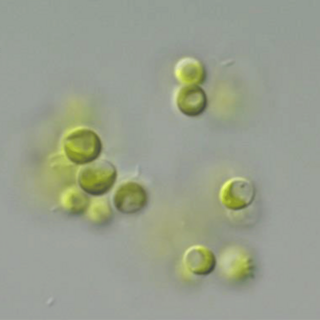
Chlorella is a genus of about thirteen species of single-celled green algae of the division Chlorophyta. The cells are spherical in shape, about 2 to 10 μm in diameter, and are without flagella. Their chloroplasts contain the green photosynthetic pigments chlorophyll-a and -b. In ideal conditions cells of Chlorella multiply rapidly, requiring only carbon dioxide, water, sunlight, and a small amount of minerals to reproduce.
Zoochlorella is a coloquial term for any green algae that lives symbiotically within the body of an aquatic invertebrate animal or a protozoan.

The euglyphids are a prominent group of filose amoebae that produce shells or tests that in most described species is reinforced by siliceous scales, plates, and sometimes spines, but this reinforcement is absent in other species. These elements are created within the cell and then assembled on its surface in a more or less regular arrangement, giving the test a textured appearance. There is a single opening for the long slender pseudopods, which capture food and pull the cell across the substrate.

Selenastraceae is a family of green algae in the order Sphaeropleales. Members of this family are common components of the phytoplankton in freshwater habitats worldwide. A few species have been found in brackish and marine habitats, such as in the Baltic Sea.

Actinastrum is a genus of mostly freshwater single-celled Eukaryotes, first described by Gustaf Lagerheim in 1882.
Auxenochlorella protothecoides, formerly known as Chlorella protothecoides, is a facultative heterotrophic green alga in the family Chlorellaceae. It is known for its potential application in biofuel production. It was first characterized as a distinct algal species in 1965, and has since been regarded as a separate genus from Chlorella due its need for thiamine for growth. Auxenochlorella species have been found in a wide variety of environments from acidic volcanic soil in Italy to the sap of poplar trees in the forests of Germany. Its use in industrial processes has been studied, as the high lipid content of the alga during heterotrophic growth is promising for biodiesel; its use in wastewater treatment has been investigated, as well.

Choricystis is a genus of green algae in the class Trebouxiophyceae, considered a characteristic picophytoplankton in freshwater ecosystems. Choricystis, especially the type species Choricystis minor, has been proposed as an effective source of fatty acids for biofuels. Choricystis algacultures have been shown to survive on wastewater. In particular, Choricystis has been proposed as a biological water treatment system for industrial waste produced by the processing of dairy goods.

Dictyosphaerium is a genus of green algae, in the family Chlorellaceae. It occurs in freshwater habitats around the world and is planktonic.

Golenkinia is a genus of green algae first described in 1894 by Robert Chodat. The genus is named for the Russian phycologist Mikhail Iljitsch Golenkin. Golenkinia species live in fresh water and are found around the world.

Mychonastes is a genus of green algae, specifically of the Chlorophyceae. It is the sole genus of the family Mychonastaceae.

Tetrastrum is a genus of green algae (Chlorophyta). It is a common component of the phytoplankton of freshwater habitats, particularly eutrophic and alkaline waters.

Chlorella sorokiniana is a species of freshwater green microalga in the Division Chlorophyta. It has a characteristic emerald-green color and pleasant grass odor. Its cells divide rapidly to produce four new cells every 17 to 24 hours. The alga was described by Martinus W. Beijerinck in 1890. In 1951, the Rockefeller Foundation in collaboration with the Japanese Government and Hiroshi Tamiya developed the technology to grow, harvest and process Chlorella sorokiniana on a large, economically feasible scale. This microalga has also been used extensively as a model system to study enzymes involved in higher plant metabolism.
Chlorella volutis is a species of euryhaline, unicellular microalga in the Division Chlorophyta. It is spherical to oval-shaped, is solitary and lacks a mucilaginous envelope.
Chlorella lewinii is a euryhaline, unicellular microalga in the Division Chlorophyta. It is spherical to oval-shaped, is solitary and lacks a mucilaginous envelope.
Chlorella singularis is a species of euryhaline, unicellular microalgae. It is spherical to oval-shaped and is solitary.
Chlorella pulchelloides is a species of euryhaline, unicellular microalga in the Division Chlorophyta. It is spherical to oval-shaped and is solitary
Chlorella pituita is a species of euryhaline, unicellular microalga in the Division Chlorophyta. It is spherical to oval-shaped and is solitary
Chlorella coloniales is a euryhaline, unicellular microalga in the Division Chlorophyta. It is spherical to oval-shaped and is solitary

Chlorella vulgaris is a species of green microalga in the division Chlorophyta. It is mainly used as a dietary supplement or protein-rich food additive in Japan.

Lemmermannia /ˌlɛməɹˈmæniə/ is a genus of fresh water trebouxiophyceans. as of March 2022, the genus contains five described species. They form coenobia of 4 to 16 cells. Its type species is L. tetrapedia (Kirchner) Lemmermann, originally described in 1880 but put into the genus Lemmermannia in 1904.










